Category: urban trees
NOW is the time to get a tree

Tree lovers, we need your help! Not only have our community tree planting events changed quite a bit due to COVID, health & safety measures mean we have very limited ability to visit communities and help neighbors get a tree of their own.
Normally we reach thousands of potential tree recipients with door-to-door canvassers and through tabling at community events – things we just can’t do this season.
Less interpersonal interaction means we won’t reach enough households about getting trees planted. And reaching fewer households means that, without your help, our neighborhoods will have far fewer new trees – and we need trees more than ever!
Here’s how you can help:
- Get a tree planted at your home. If you’ve been thinking about getting a tree, now’s the time.
- Talk to your neighbors about getting a tree. How many tree-less front yards are on your street? How about tree-less planting strips? (the area between the sidewalk and street). Visit your neighbors (masked, of course 😉 and help spread the good word about trees through forwarding this email or sharing this link.
Getting a tree with Friends of Trees is easy, informative, and affordable!
- The cost to you for a tree is a very affordable $35. Considering that tree would sell in a nursery for much more, plus when it’s from Friends of Trees you get delivery, a hole dug, expert planters, and post-planting support, it’s a great deal!
- We have a sliding scale available if $35 is too much – name your price! And if you can afford more than $35 anything extra will go to our tree scholarship fund.
- Your tree can be FREE if need be, thanks to our tree scholarship fund (donate to the tree scholarship fund here!)
Check out how easy it is to get a tree, and our wide variety of trees, here.
Questions? Email or call the Tree Team at (503)595-0212. We can’t wait to introduce you to your new tree!
Please note that this information applies to the Portland Metro area; for information about getting a tree in our Eugene service area please contact our Eugene office.
This information was featured in the September 2020 edition of Treemail, our monthly e-news; read the whole issue here, and catch up on other Treemail issues here.
Simple ways to protect your tree on windy days
The Pacific Northwest is experiencing a historic windstorm event in September, 2020. These winds can cause serious damage to both young and established trees. When the winds pick up, you can take some simple steps to prevent damage to your tree friend.
What should I do to protect my trees from wind?
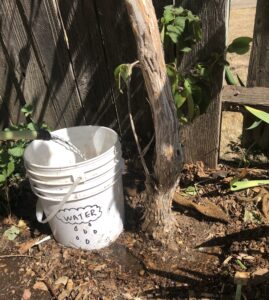
Wind causes leaves to dry out more quickly. That’s why it’s important to make sure tree roots have access to water in the soil to replenish the water lost through their leaves. If trees don’t have enough access to water in the soil, the leaves can dry out, and potentially cause dieback.
- Newly planted trees (1-5 years since planting): Make sure to give young trees a nice, deep soaking of the root zone with about 10-15 gallons of water. That’s three large buckets of water, slowly added to the soil. Make sure you soak all of the soil within two feet of the trunk, and imagine you are trying to reach the roots about a foot deep in the soil.
- Established trees (5+ years): This is a great job for a soaker hose or sprinkler, slowly moistening the soil around the edge of the canopy of the tree. Some mature trees are already experiencing drought stress, so it’s extra important to give them an extra drink during windy periods.
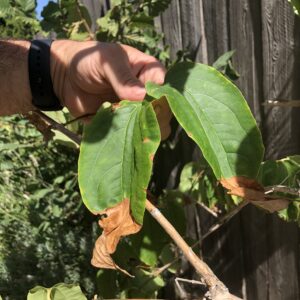
Why does my tree lose water through its leaves?
Water loss through leaves is due to a process called transpiration, which is essentially the process that occurs after your tree takes up water from the soil, uses it for photosynthesis, and then releases it back into the air. The US Geological Survey explains it this way:
“The typical plant, including any found in a landscape, absorbs water from the soil through its roots. That water is then used for metabolic and physiologic functions. The water eventually is released to the atmosphere as vapor via the plant’s stomata — tiny, closeable, pore-like structures on the surfaces of leaves.”
That water (H2O), of course, plays an important role in photosynthesis while inside the plant, reacting with carbon dioxide (CO2) to produce some delicious sugars for the plant to eat (C6H12O6) and some complimentary fresh oxygen (O2) for us!
So, why does the wind cause tree leaves to dry out more quickly?
Because water likes to distribute itself evenly, it will tend to move from a moist location to a drier location. If the inside of the leaf is moist, and the outside air is also moist, water won’t feel the need to jump ship.
But, as Wikipedia explains, “wind blows away much of this water vapor near the leaf surface…speeding up the diffusion of water molecules into the surrounding air.” The wind moves the moisture away from the leaf, encouraging more water to exit the leaf and re-moisten the surrounding air.
So, keep an eye out for dry/windy weather in the forecast, and make sure your trees and plants are prepared. And give special attention to evergreens in windy/dry periods during the winter, as these trees with year-round leaves and needles will transpire year-round as well.
DYK? Trees are also stormwater filters!
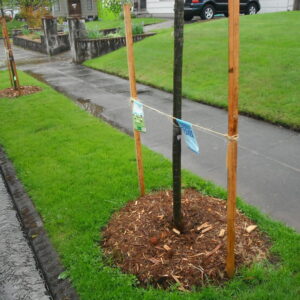
Why all the fuss about managing stormwater? Simply put, stormwater pollutes waterways.
“Stormwater runoff carries dirt, oil and other pollutants to rivers and streams. It can also cause erosion and flooding that harm properties and wildlife habitat.“1
“Portland’s trees are also playing an underappreciated role every time it rains: They’re helping us prevent major flooding and avoid erosion; they are literally holding Multnomah County together.” 4
Traditionally, and still common throughout the country, stormwater is primarily managed through “grey” solutions such as massive construction and excavation projects that install giant pipes to divert the wastewater. Thinking green, Portland conducted a study and found there could be significant savings in the cost of the Big Pipe project by including green infrastructure along with wider sewer pipes.2 Other cities are catching on; Friends of Trees regularly receives inquiries from other cities (a recent call came from Louisville, KY) looking for more information about this partnership and its benefits.
Per an agreement between Portland Parks and Recreation and BES, “Portland’s Bureau of Environmental Services recognizes that, among the numerous environmental, economic, and social benefits trees provide, they can work for clean rivers by helping to manage stormwater where it falls. Planting trees can expand and enhance the urban forest canopy and help the city meet key goals of several plans,” including the City’s Climate Action Plan and Watershed Management Plan.3
In other words, BES recognizes the multiple bottom line trees deliver, and how essential trees are to a healthy, equitable and livable city. For more information about trees and stormwater management (and to check out a very cool interactive model that demonstrates trees’ impact), visit our friends at the Arbor Day Foundation. And when you can safely swim in a river or eat fish from a lake this summer be sure to thank the trees.
Trees: Fighting climate change, growing community AND managing stormwater
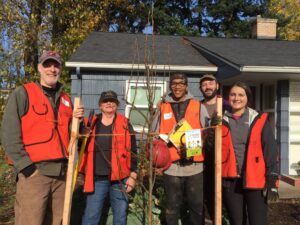
In 2008, Friends of Trees and the City of Portland Bureau of Environmental Services embarked together on a transformative journey to boost green infrastructure in Portland. This initiative built on the Big Pipe project and used green infrastructure to reduce environmental impacts of urban stormwater. Along with creating bioswales, installing green roofs and adding new natural areas, this project mandated the planting of tens of thousands of trees in Portland.
This partnership resulted in 38,000+ street trees planted in Portland from 2008 – 2021, and these street trees intercept 9.6 million gallons of rain each year.1 The trees planted through this partnership represent just a portion of all street and yard trees planted by Friends of Trees since 1989, which is more than 50,000 across the region.
Why all the fuss about stormwater? Learn more here.
This project didn’t just plant small trees and hope for the best. Then-Mayor Sam Adams prioritized planting and caring for large stock trees. Planting larger trees means, of course, that all of the benefits are realized much sooner than if smaller trees were planted.
Caring for the trees is equally important: Friends of Trees’ program includes post-planting support and care, which helps ensure that the trees we plant survive and thrive. Our monitoring program builds on that, telling us how many of the trees we plant survive—and our trees have an excellent survival rate: The survival rate for urban trees planted by Friends of Trees is 97% (based on Portland street trees planted during our last two seasons).
It’s not just stormwater. These trees deliver a triple bottom line, beyond stormwater management:
1. Most of the trees planted through this partnership are planted in historically under-served, low-canopy neighborhoods, bringing the countless benefits of trees to the neighborhoods that need them most.
2. The trees planted are now on the front lines of fighting climate change; each tree we plant will offset 13-48 lbs. of carbon annually.2
3. When planted the Friends of Trees way, with thousands of volunteers, trees grow community. And now more than ever, we need ways to come together as a community, and we need trees.
We’re not done! About 100,000 street tree planting locations remain available in Portland, not to mention throughout our service area that runs from Southwest Washington down to Lane County. We plant a lot of trees every year: Just last season we planted 3,500 street & yard trees and 46,000 seedlings and native shrubs. We know our region and our planet needs more trees and more community-building, and we look forward to enhancing and expanding the wide variety of partnerships we enjoy toward planting a greener and healthier future.
- Data provided by City of Portland Bureau of Environmental Services
- Depending on the age of the tree.
Some of this content is from a video about the project, check it out here.
A lot of trees and tree stories – 16,000+ trees planted so far this season!
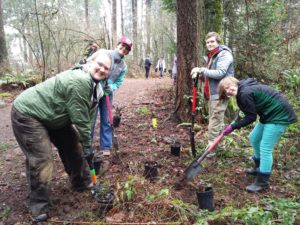
“It was an amazing day, perfect weather, awesome people and healthy trees! Couldn’t ask for a better planting day, truly.” Alex, volunteer tree planter (above photo taken at our Gresham planting event)
So far in our 2019-20 planting season we’ve planted more than 16,000 trees and native shrubs! Here are some highlights from some amazing days this season:
Neighborhood Trees Program: 820 trees planted

“It was wonderful to plant in our neighborhood! I look forward to checking up on all of our trees over the next few years.” -Neighborhood Trees volunteer planter
Green Space Program: 15,800 trees planted

“The team created a warm and welcoming environment. It was a lovely event that we truly enjoyed!” -Green Space planting volunteer
